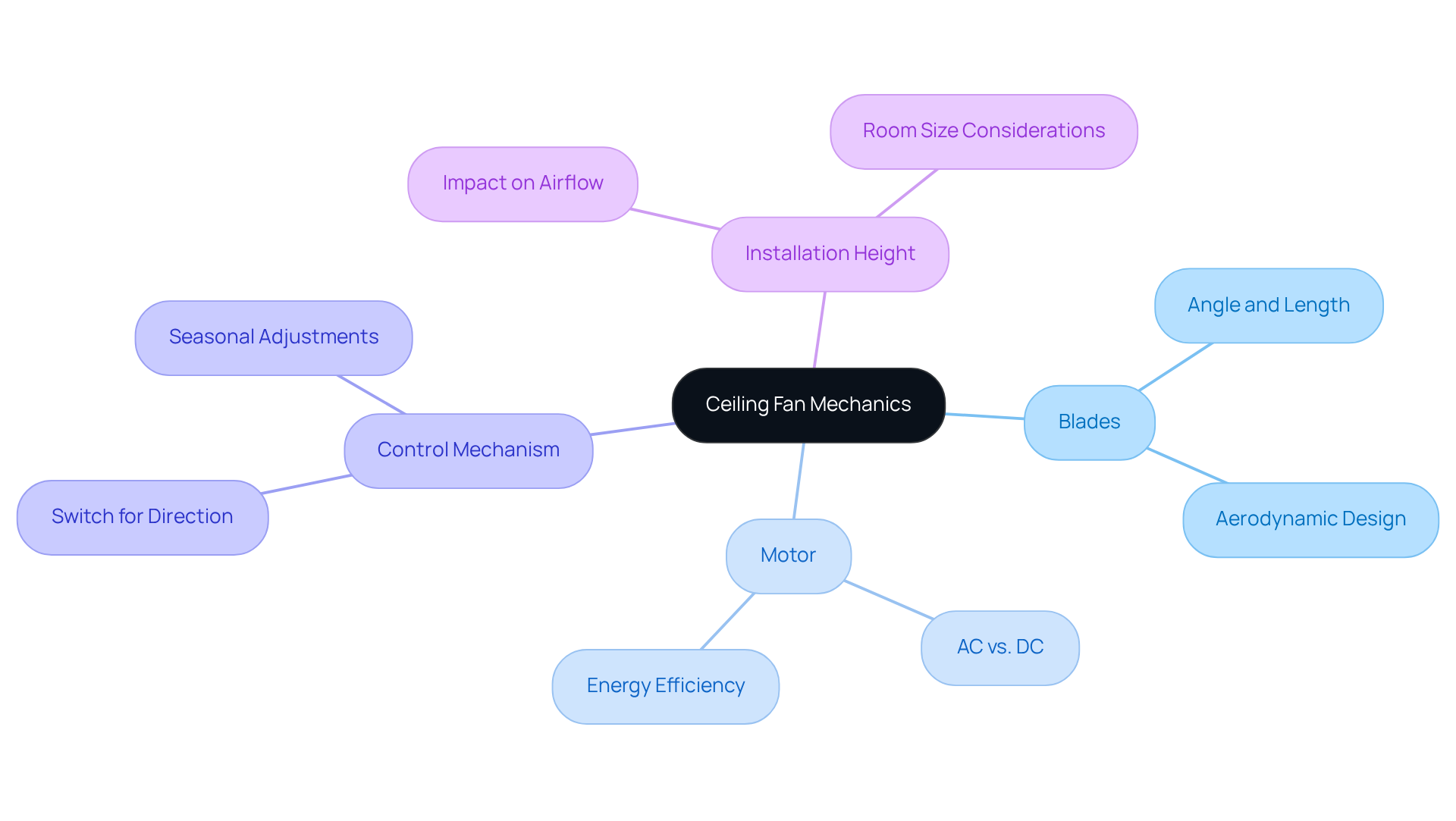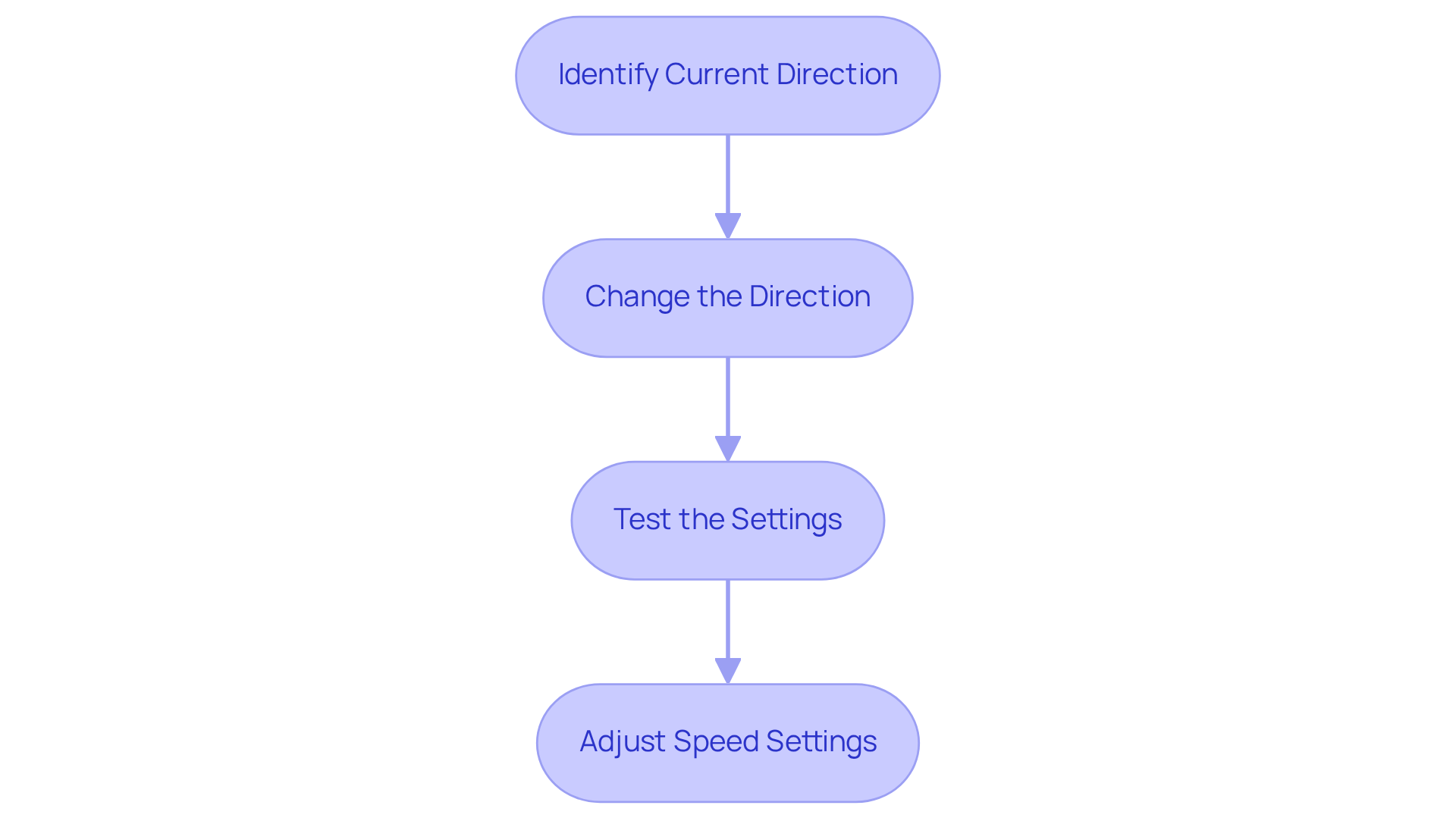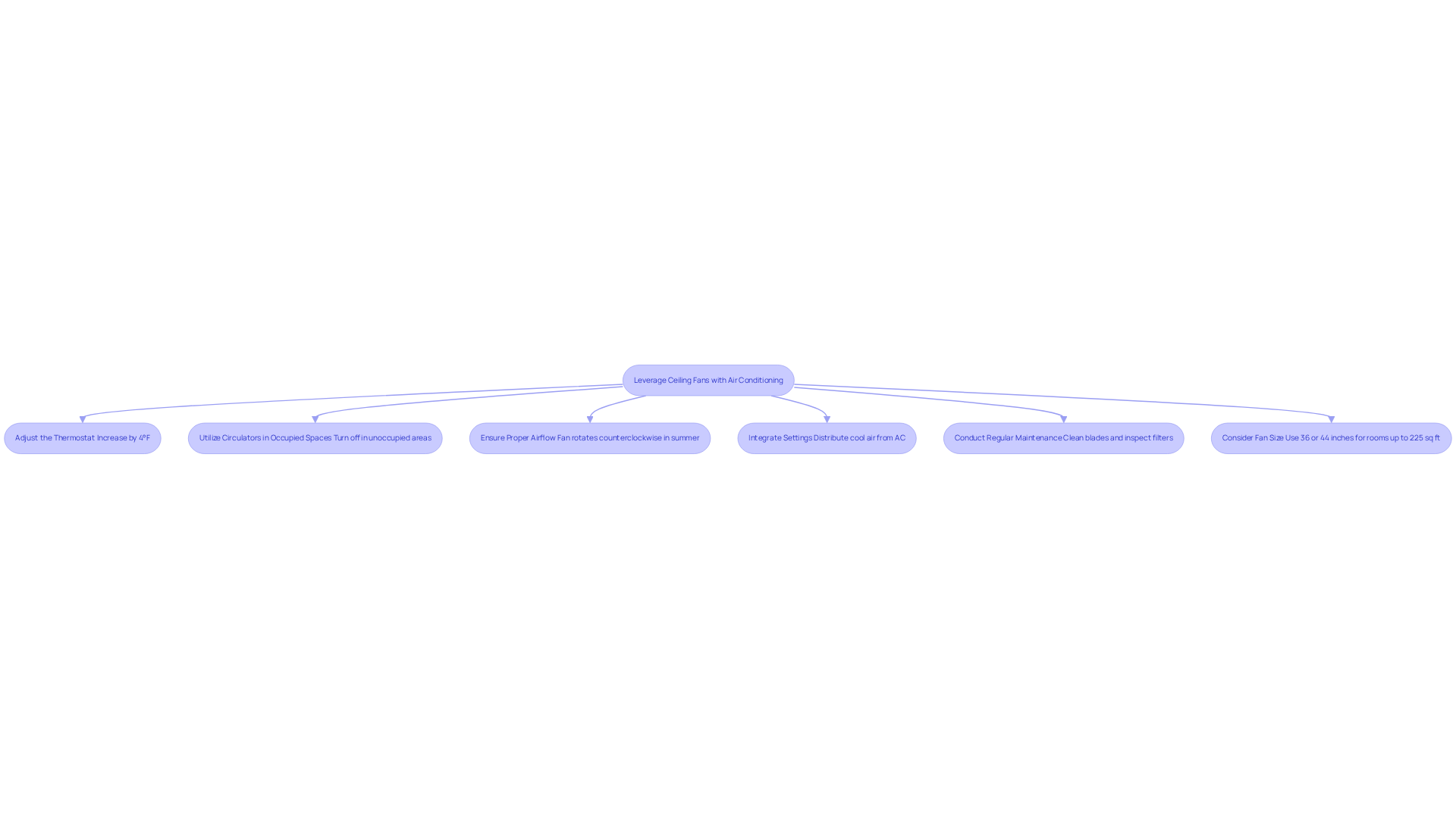Overview
This article presents three essential steps for effectively rotating ceiling fans to enhance comfort:
- Adjusting the fan direction based on seasonal needs
- Testing airflow
- Modifying speed settings
Proper fan direction is crucial—counterclockwise in summer for cooling and clockwise in winter for warmth redistribution. This adjustment can significantly improve indoor comfort and energy efficiency, as evidenced by practical guidelines and statistics on energy savings. Implementing these steps not only optimizes comfort but also maximizes energy efficiency in your living space.
Introduction
Understanding the mechanics of ceiling fans can significantly enhance a home’s comfort level and reduce energy costs. By mastering fan rotation, homeowners can cultivate an inviting atmosphere—whether it’s a refreshing breeze during the summer or a cozy warmth in the winter.
Despite these advantages, many individuals remain unaware of how to adjust their ceiling fans effectively to maximize these benefits. Simple changes in fan direction and speed can lead to a more comfortable living space throughout the year.
How can you harness this knowledge to transform your environment?
Understand Ceiling Fan Mechanics
Ceiling devices operate using a fan rotating with spinning propellers that generate airflow, capable of either chilling or distributing warm air depending on the rotation direction. Most ceiling fans with a motor allow for the paddles to rotate in two directions: clockwise and counterclockwise. In the summer, a fan rotating counterclockwise should help push cool air downward, creating a wind-chill effect that makes the room feel cooler. Conversely, in winter, the fan rotating clockwise at a low speed helps pull cool air up and push warm air down, effectively redistributing heat throughout the room. Understanding these mechanics is crucial for optimizing comfort and energy efficiency in your home.
Key Components of Ceiling Fans
- Blades: The angle and length of the blades significantly influence airflow. Longer edges can move more air, and the design of the fan components, including their pitch and shape, plays a critical role in airflow performance. Chelsee Sims notes that their engineering team developed a contoured, aerodynamic blade design for SureSpeed ceiling devices, enhancing air movement compared to conventional flat blades.
- Motor: The type of motor (AC or DC) affects energy efficiency and noise levels. Optimized motors, such as those found in SureSpeed devices, provide improved airflow with reduced energy consumption.
- Control Mechanism: Most fans include a switch to change the fan rotating direction, which is essential for seasonal adjustments.
- Installation Height: The distance between the fan and the ceiling or floor impacts airflow and must be chosen based on the fan style, room size, and height of the upper surface.
Utilizing a fan allows homeowners to without sacrificing comfort, as reported by the U.S. Department of Energy. This statistic underscores the energy efficiency aspect and offers a practical takeaway for the audience. Understanding these factors is vital for maximizing comfort and energy efficiency in your home.

Adjust Fan Direction for Seasonal Comfort
To optimize your ceiling fan for seasonal comfort, follow these essential steps:
- Identify the current direction: Stand beneath the fan rotating and observe the blade movement. If it’s spinning counterclockwise, it’s set for summer cooling.
- Change the Direction: Locate the switch on the fan’s motor housing. Flip the switch to reverse the rotation. For summer, ensure the fan is rotating counterclockwise; for winter, it should be rotating clockwise to circulate warm air effectively.
- Test the Settings: Turn on the fan and feel the airflow. In summer, you should experience a refreshing breeze from the fan; in winter, the gentle airflow from the fan should be directed upwards to distribute warmth evenly.
- Adjust Speed Settings: In summer, set the fan to a higher speed for a stronger cooling effect. In winter, a lower speed is adequate to circulate warm air without creating a draft.
By making these adjustments, you can enhance comfort while potentially reducing energy costs. Implementing these simple changes can lead to significant energy savings and improved indoor comfort throughout the year.

Leverage Ceiling Fans with Air Conditioning
To maximize the efficiency of your ceiling fans in conjunction with your air conditioning system, consider implementing the following strategies:
- Adjust the Thermostat: Increase your thermostat setting by approximately 4°F when utilizing an overhead fan. This adjustment can significantly alleviate the strain on your air conditioning unit while maintaining comfortable levels. It is essential to remember that ceiling fans do not lower the room temperature; rather, they create a wind chill effect that enhances your comfort.
- Utilize Circulators in Occupied Spaces: Ceiling circulators demonstrate their highest effectiveness in areas where individuals are present. To conserve energy, it is advisable to switch off fans in unoccupied spaces.
- Ensure proper airflow by ensuring your fan rotates counterclockwise during the summer months to amplify the cooling effect, fostering a more comfortable environment.
- Integrate Settings: Employ the overhead fan to aid in distributing the cool air generated by your air conditioning unit, achieving a consistent temperature throughout the room.
- Conduct Regular Maintenance: Regular maintenance of both your overhead fan and air conditioning system is crucial for optimal performance. Consistently clean fan blades and inspect air filters to guarantee efficient operation.
- Consider Fan Size: For rooms up to 225 square feet, it is recommended to use a fan with a diameter of 36 or 44 inches for optimal performance.
- Follow Manufacturer Instructions: Always comply with the manufacturer’s guidelines regarding optimal placement and safety measures.
By adopting these practices, you can cultivate a comfortable living space while effectively managing energy consumption. Notably, operating a ceiling fan incurs a cost of , in stark contrast to about 36 cents per hour for central air conditioning, underscoring the potential for significant energy savings.

Conclusion
Understanding the mechanics and optimal usage of ceiling fans is essential for enhancing comfort in any home. By adjusting the fan’s rotation direction according to the seasons, homeowners can significantly improve their indoor climate while also boosting energy efficiency. This knowledge not only leads to a more pleasant living environment but also helps in reducing energy costs.
Key insights from the article highlight the importance of:
- Fan blade design
- Motor efficiency
- Proper installation height in maximizing airflow
Seasonal adjustments, such as:
- Reversing the fan direction
- Altering speed settings
are crucial for achieving the desired comfort levels throughout the year. Additionally, leveraging ceiling fans alongside air conditioning systems can lead to substantial energy savings, allowing for a comfortable atmosphere without excessive energy expenditure.
Ultimately, implementing these strategies can transform the way ceiling fans contribute to home comfort. By taking proactive steps to optimize fan usage, individuals can enjoy a more sustainable and enjoyable living space. Consider these tips and make the necessary adjustments to your ceiling fans to experience the full benefits of enhanced airflow and energy efficiency in your home.
Frequently Asked Questions
How do ceiling fans work?
Ceiling fans operate by rotating blades that generate airflow, which can either cool or distribute warm air, depending on the direction of rotation.
What is the recommended fan rotation direction for summer?
In the summer, the fan should rotate counterclockwise to push cool air downward, creating a wind-chill effect that makes the room feel cooler.
What is the recommended fan rotation direction for winter?
In winter, the fan should rotate clockwise at a low speed to pull cool air up and push warm air down, effectively redistributing heat throughout the room.
What are the key components of a ceiling fan?
The key components of a ceiling fan include the blades, motor, control mechanism, and installation height.
How do the blades affect ceiling fan performance?
The angle and length of the blades significantly influence airflow; longer blades can move more air, and their design affects overall performance.
What types of motors are used in ceiling fans, and how do they differ?
Ceiling fans typically use either AC or DC motors, with DC motors generally providing better energy efficiency and quieter operation.
How can a ceiling fan help with energy efficiency?
Utilizing a ceiling fan allows homeowners to raise their thermostat setting by up to 4 degrees without sacrificing comfort, promoting energy efficiency.
Why is the installation height of a ceiling fan important?
The installation height impacts airflow and should be chosen based on the fan style, room size, and height of the ceiling to optimize performance.

